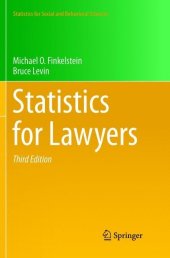 Neuerscheinungen 2019Stand: 2020-02-01 |
Schnellsuche
ISBN/Stichwort/Autor
|
Herderstra▀e 10
10625 Berlin
Tel.: 030 315 714 16
Fax 030 315 714 14
info@buchspektrum.de |

Michael O. Finkelstein, Bruce Levin
(Beteiligte)
Statistics for Lawyers
3. Aufl. 2019. xxxii, 657 S. 56 SW-Abb., 65 Tabellen. 235 mm
Verlag/Jahr: SPRINGER, BERLIN; SPRINGER NEW YORK; SPRINGER 2019
ISBN: 1-493-97924-8 (1493979248)
Neue ISBN: 978-1-493-97924-0 (9781493979240)
Preis und Lieferzeit: Bitte klicken
This classic text, first published in 1990, is designed to introduce law students, law teachers, practitioners, and judges to the basic ideas of mathematical probability and statistics as they have been applied in the law. The third edition includes over twenty new sections, including the addition of timely topics, like New York City police stops, exonerations in death-sentence cases, projecting airline costs, and new material on various statistical techniques such as the randomized response survey technique, rare-events meta-analysis, competing risks, and negative binomial regression. The book consists of sections of exposition followed by real-world cases and case studies in which statistical data have played a role. The reader is asked to apply the theory to the facts, to calculate results (a hand calculator is sufficient), and to explore legal issues raised by quantitative findings. The authors┤ calculations and comments are given in the back of the book. As with previous editions, the cases and case studies reflect a broad variety of legal subjects, including antidiscrimination, mass torts, taxation, school finance, identification evidence, preventive detention, handwriting disputes, voting, environmental protection, antitrust, sampling for insurance audits, and the death penalty. A chapter on epidemiology was added in the second edition. In 1991, the first edition was selected by the University of Michigan Law Review as one of the important law books of the year.
"It is a worthy update of very successful two earlier editions and should be an interesting reading for both lawyers who desire a gateway to statistical jargons and statisticians who┤re interested in finding interesting interdisciplinary statistical problems in legal settings." (Z. Q. John Lu, Technometrics, Vol. 58 (4), April, 2016)
"The dangers of misusing statistics are illustrated by the case of People vs. Collins, in which the product of the probabilities of several characteristics described by eyewitnesses ... was presented as convincing evidence against the defendant. This book analyses this and numerous other interesting examples to show the relevance of statistics to forensic science, medicine, commerce and the law. Each of the statistical concepts and procedures is presented with examples that include exercises based on actual data. ... The book is quite readable." (Dr. Henry Roberts, Australian Journal of Forensic Sciences, Vol. 35, 2003)
"This is the first book on statistics for lawyers that has come out in a second edition. ... The most impressive change in the book can be attributed to the publisher, who has included the book in its relatively new series on Statistics for Science and Public Policy. First published as an inexpensive softcover edition, the book is now a beautiful hardcover volume ... . this book continues to be a wonderful resource for the use of statistics in the courts." (Technometrics, Vol. 44 (2), 2002)
"This book is designed to introduce law students, law teachers, practitioners, and judges to the basic ideas of mathematical probability and statistics as they are applied in the law. ... The cases and case studies reflect a broad variety of legal subjects, including antidiscrimination, mass torts, taxation, school finance, identification evidence ... and the death penalty. ... Significant new developments, reflected in this edition, include, for example, DNA evidence, epidemiologic studies in toxic substance litigation, statistical models for adjusting census counts, and vote-dilution cases." (Edward M. Psyadlo, Zentralblatt MATH, Vol. 983, 2002)


